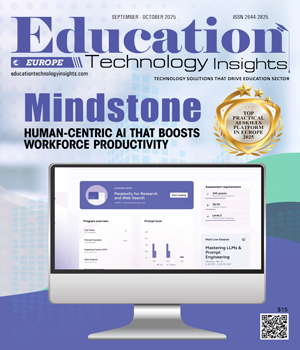THANK YOU FOR SUBSCRIBING
Be first to read the latest tech news, Industry Leader's Insights, and CIO interviews of medium and large enterprises exclusively from Education Technology Insights
Strategic Implementation of AI-Assisted Grading: Considerations for Academic Leaders
Jean Mandernach, Executive Director, Center for Innovation in Research and Teaching, Grand Canyon University
 Jean Mandernach, Executive Director, Center for Innovation in Research and Teaching, Grand Canyon University
Jean Mandernach, Executive Director, Center for Innovation in Research and Teaching, Grand Canyon UniversityArtificial intelligence is rapidly transforming assessment practices in higher education, offering promising solutions to address faculty workload challenges while maintaining highquality feedback. Research indicates that in online teaching environments, faculty dedicate approximately 41% of their instructional hours to grading and feedback, significantly outweighing time spent on content development or student interaction (Mandernach, Hudson, & Wise, 2013). A typical online instructor teaching a course with 22 students spends about 12.7 hours per week on course management, with roughly 5 hours dedicated solely to evaluating assignments and providing written feedback (Mandernach & Holbeck, 2016). This workload has only intensified in recent years, with 78% of faculty reporting increased demands on their time (Educause, 2022) and 86% expressing a desire to reduce time spent on repetitive grading tasks (Interfolio, 2022). As institutions explore AI-assisted grading solutions, administrators must thoughtfully navigate implementation to ensure these tools enhance rather than undermine educational values.
Approaches to AI-Assisted Grading
Educational institutions can implement AI-assisted grading through two distinct paths: specialized AI grading platforms or general-purpose generative AI tools.
Specialized platforms integrate directly with learning management systems and offer rubric-based evaluation capabilities customized to institutional standards. They typically include built-in FERPA compliance measures and promote consistency in feedback delivery while accommodating disciplinary differences. These platforms emerge either as commercial products or as proprietary systems developed internally by institutions.
“A well-implemented system enhances—not replaces—the role of educators by amplifying instructional impact and promoting consistent, high-quality feedback”
The general-purpose approach leverages AI tools not specifically designed for education. Faculty use large language models to generate initial feedback drafts that they review and refine. This requires developing effective prompting strategies for educational assessment, inevitably including faculty modification of AI-generated content. While offering greater flexibility and accessibility, these tools typically lack built-in security features and educational specificity.
Essential Implementation Components
Governance Frameworks: Effective governance is crucial for successful AI implementation. A well-designed structure should include diverse representation—faculty from various disciplines, students, IT professionals, instructional designers, and legal/ privacy experts—ensuring that technical decisions balance with pedagogical and ethical considerations. Governance bodies should have clearly defined responsibilities covering policy development, vendor evaluation, implementation oversight, continuous evaluation, and conflict resolution.
Policy Development: Comprehensive policies must address data governance, academic integrity, and ethical frameworks. Data governance policies should establish procedures for data retention, access controls, consent mechanisms, and secure handling protocols. Academic integrity policies need updates to clarify legitimate AI use in grading, formalize human review requirements, and establish procedures for contesting evaluations. Ethical frameworks should articulate commitments to equity, transparency, faculty academic freedom, and alignment with institutional values.
Clear Expectations: Faculty need clear role clarification and understanding of both their responsibilities and authority in AI-assisted environments. They must maintain final authority over grades and feedback, with systems designed to support rather than replace professional judgment. Institutions should develop comprehensive training programs and establish communication standards for informing students about AI's role in assessment.
Data Privacy and Compliance: Student work and grades receive protection under educational privacy laws like FERPA, creating significant legal and ethical obligations. Specialized educational platforms typically offer specific data protection guarantees, while general-purpose AI tools present more challenging privacy landscapes. Institutions must develop strict protocols, particularly when using general AI tools, potentially including strategies like anonymizing student work or obtaining explicit consent for AI analysis.
Equity and Fairness: AI systems risk perpetuating biases, potentially undervaluing contributions from non-native English writers or those using culturally diverse examples. Institutions should establish protocols for regular bias testing and mitigation, including comparative analysis of AI evaluations across student populations and monitoring systems that track assessment outcomes by relevant demographic factors.
Transparency and Accountability: Transparent communication builds trust around AI-assisted assessment. Students and faculty need to understand how feedback is generated, AI's role in the process, and how human oversight ensures quality. Regular reporting mechanisms should monitor system performance, collect user experiences, and evaluate educational impact, examining both technical metrics and pedagogical outcomes.
Conclusion
AI-assisted grading presents a significant opportunity to address faculty workload challenges while potentially enhancing feedback quality. A well-implemented system enhances—not replaces—the role of educators by amplifying instructional impact and promoting consistent, high-quality feedback. However, these benefits only materialize when systems are built and maintained with integrity, clarity, and ongoing oversight that puts educational principles first.
Read Also
Empowering Educators through Purposeful, Connected and Transformative Learning
Empowering Students to Lead: A New Vision for Civic Learning
The Director's Playbook: Strategic Digital Transformation in Rual Hyper-Growth Districts
The Art and Architecture of Student Support
From At-Risk to At-Promise: The Language Revolution Higher Education Needs
Teaching Tomorrow: How Western Governors University Is Redefining Teacher Preparation

I agree We use cookies on this website to enhance your user experience. By clicking any link on this page you are giving your consent for us to set cookies. More info

However, if you would like to share the information in this article, you may use the link below:
www.educationtechnologyinsightseurope.com/cxoinsights/jean-mandernach-nid-3206.html





















